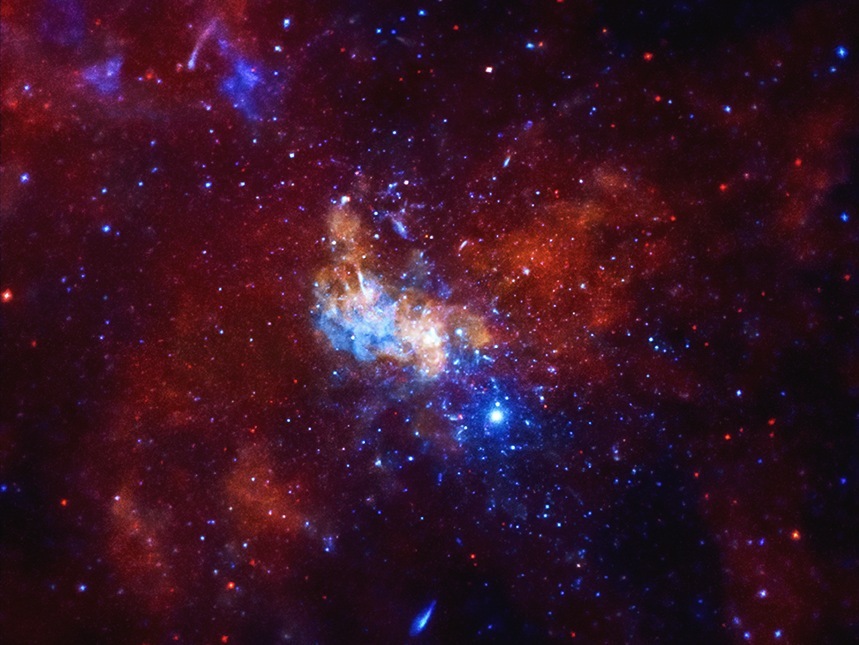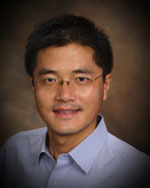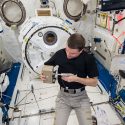Telescopes hint at neutrino beacon at the heart of the Milky Way

Correlating X-ray emissions from Sagittarius A, a massive black hole at the center of the Milky Way shown above, with IceCube Neutrino Observatory data, UW researchers have seen hints that the black hole is emitting neutrinos.
Image: NASA
Identifying the sources of high-energy neutrinos — ghostly but potentially information-rich particles believed to be generated by some of the most violent objects in the sky — is near the top of many an astrophysicist’s bucket list.
By their nature, high-energy neutrinos are very difficult to detect and follow back to their points of origin. Things like gamma ray bursts, colliding galaxies, black holes, newly forming stars and other dynamic celestial phenomena, scientists believe, are what kick-start high-energy neutrinos and send them on their course through the cosmos. The subatomic particles have no charge, almost no mass, and can zip through planets, stars and entire galaxies without skipping a beat.
But thanks to a confluence of data from a suite of vastly different telescopes, including three orbiting X-ray telescopes and the IceCube Neutrino Observatory sunk deep into the ice beneath the South Pole, there are tantalizing clues that the massive black hole at the core of the Milky Way may be one such cosmic accelerator.
Should scientists confirm the observations, it would be the first time neutrinos have been detected emanating from a black hole.

Yang Bai
In a recent paper published in the journal Physical Review D, a team led by University of Wisconsin–Madison physicist Yang Bai reports a correlation of IceCube data with a recorded burst of X-rays from Sagittarius A, an object at the center of our galaxy that is believed to be a supermassive black hole.
“We have a hint that an IceCube neutrino is associated with a light source, an X-ray source,” says Bai, a UW–Madison assistant professor of physics.
Last year, the IceCube Neutrino Observatory, run by an international collaboration at the UW–Madison-based Wisconsin IceCube Particle Astrophysics Center (WIPAC), reported the detection of 28 extremely high-energy neutrino events, the first time the most energetic form of neutrinos had been detected coming from extraterrestrial sources. Previously, less energetic forms of neutrinos were documented emanating from the supernova 1987a.
One of those very energetic IceCube events, according to Bai and his colleagues, was detected just a few hours after a bright, transient X-ray flare was observed emanating from Sagittarius A by the orbiting Chandra Observatory. Together with two other IceCube-detected particle showers nearest the plane of the galaxy, events that occurred within a day of each other and that were observed by the Swift X-ray Telescope and the Nuclear Spectroscopic Telescope Array (NuSTAR), the observation provides tentative evidence that very high energy neutrinos can be associated with a black hole.
“Thus, the determination that some IceCube events occur at similar times as X-ray flares and others occur in a burst could be the smoking gun that Sagittarius A is a point source of very high energy neutrinos,” Bai and his colleagues write in their Physical Review D report.
Should scientists confirm the observations, it would be the first time neutrinos have been detected emanating from a black hole.
Neutrinos are generated by nuclear reactors and the Earth is subjected to a constant bombardment of the nearly massless particles from the sun. Neutrinos from beyond our solar system, however, can be far more energetic — millions or billions of times more energetic than solar and other more pedestrian forms of neutrinos. And because neutrinos carry no charge and thus are not affected by the magnetic fields that litter the cosmos, and because they rarely interact with matter, they can travel cosmological distances completely unchanged. That ghostlike quality, scientists believe, means high-energy neutrinos likely harbor a trove of pristine astrophysical information about some of the most energetic events in the cosmos.
The IceCube Observatory, built with support from the National Science Foundation and other governments worldwide, uses the deep, clear ice of the Antarctic as a medium in which to look for the telltale signatures of very high-energy neutrinos. In 2013, the IceCube collaboration reported the detection of three dozen high-energy neutrino events. It was those events that Bai and his colleagues used to match up with observations made by Chandra, and the Swift and NuSTAR telescopes.
Co-authors of the new study include Amy Barger, Vernon Barger, Ran Lu, Andrea Peterson and Jordi Salvado, all of UW–Madison.
Tags: IceCube, physics, research, space & astronomy



